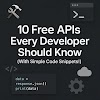Model Context Protocol (MCP) is a game-changer for how we structure prompts, share context, and build AI agents that work reliably across tasks. Whether you're tinkering with automation scripts using GPT or building full-fledged AI tools, understanding MCP helps you level up your workflow.
In this tutorial, we’ll walk through what MCP is, how it works, and how you can start using it in practical, snippet-by-snippet steps. Let’s demystify MCP, one piece at a time.
🔍 What is MCP and Why Should You Care?
MCP (Model Context Protocol) is a standardized format for describing roles, goals, tools, inputs, and memory when working with large language models (LLMs). It helps you:
- Make prompts more predictable and reusable
- Enable multi-agent collaboration
- Pass clean context between tools and functions
- Structure workflows in automated, modular ways
If you’ve ever felt your prompts were becoming messy, repetitive, or fragile, MCP is for you.
🚀 Let’s Build: A Simple MCP-Powered AI Assistant (Snippet-by-Snippet)
We’ll build a basic AI assistant using Python + OpenAI API, structured with MCP. This setup gives your AI context like a professional agent would have — without manually re-typing every detail.
🧩 Step 1: Install Required Tools
Let’s start with the Python tools needed for MCP-style prompt building.
🔸 Snippet:
pip install openai python-dotenv
💡 Explanation:
openai: For interacting with the OpenAI API.python-dotenv: Helps manage your API keys securely from a.envfile.
📁 Step 2: Set Up Your .env File
To keep things secure and clean, store your OpenAI API key in a .env file.
🔸 Snippet:
OPENAI_API_KEY=your-api-key-here
💡 Explanation:
This file is ignored by Git (if you use a .gitignore) and keeps your API key out of your source code, which is essential for safety.
🧠 Step 3: Create the Basic MCP Structure
We’ll define the roles, goals, and tools of our assistant in Python. This is where MCP shines.
🔸 Snippet:
# context.py
mcp_context = {
"role": "You are an AI assistant helping users automate small tasks using Python.",
"goal": "Generate Python scripts based on user prompts, clearly and concisely.",
"tools": ["code generation", "task planning", "error explanation"],
"memory": [],
"input": ""
}
💡 Explanation:
- Role: Describes who the model is.
- Goal: What it’s trying to achieve.
- Tools: Capabilities the AI can use (important if you plan tool calling).
- Memory: Placeholder for storing past interactions (can be expanded later).
- Input: The current user query (will be added dynamically).
This structure can be reused in different prompts or even shared between agents — one of MCP’s biggest advantages!
💬 Step 4: Generate a Prompt from MCP
Now let’s write a function that takes user input and combines it with the MCP context.
🔸 Snippet:
# prompt_builder.py
def build_prompt(user_input, context):
context["input"] = user_input
return f"""{context['role']}
Your goal: {context['goal']}
You can use: {', '.join(context['tools'])}
User input: {context['input']}
"""
💡 Explanation:
This function dynamically builds a prompt with clear structure — the role, goal, tools, and user input all included.
This is a lightweight but powerful version of MCP prompting. It helps the model stay on track and produce relevant outputs.
🧠 Step 5: Generate a Response from OpenAI
Let’s put it all together and actually use the OpenAI API to get a response from our assistant.
🔸 Snippet:
# main.py
import openai
from dotenv import load_dotenv
import os
from prompt_builder import build_prompt
from context import mcp_context
load_dotenv()
openai.api_key = os.getenv("OPENAI_API_KEY")
user_input = input("What do you need help automating with Python? ")
prompt = build_prompt(user_input, mcp_context)
response = openai.ChatCompletion.create(
model="gpt-4",
messages=[
{"role": "system", "content": prompt}
],
temperature=0.7
)
print("\nAI Assistant:\n", response['choices'][0]['message']['content'])
💡 Explanation:
openai.ChatCompletion.create: Sends our MCP-based prompt to GPT-4.- We use
"system"role for the full structured prompt — this works well for keeping the model grounded. - This assistant is now goal-aware, tool-aware, and role-driven — thanks to MCP.
🧠 Step 6: (Optional) Add Memory to Context
You can easily evolve this setup to store memory — for example, saving user preferences or previous prompts.
🔸 Snippet:
# Add this to prompt_builder.py
def add_to_memory(context, item):
context["memory"].append(item)
💡 Explanation:
This allows your assistant to retain past context — which is part of MCP’s power when building persistent, agent-like tools.
📝 Gentle Reminder
To see the full working result, combine all the code snippets above — each one plays a key part in structuring a smart AI assistant with MCP.
✅ Best Practices for Using MCP
- Be specific with roles and goals — vague prompts lead to vague answers.
- Treat tools as capabilities — you can later wire these into function-calling.
- Keep context modular — MCP is made to be reused across apps and agents.
- Document your MCP blocks — especially if collaborating with other devs.
🔗 How MCP Helps with SEO & Automation
Using MCP makes your AI workflows more consistent and scalable, which means:
- Faster development of tools like automated content generators
- More structured prompts = better outputs for SEO content or marketing copy
- Easier integration into automated workflows like Zapier or backend scripts
🧠 Wrapping Up
Model Context Protocol (MCP) is more than just prompt formatting — it’s a framework for building smarter, structured AI workflows.
In this post, you’ve learned:
- What MCP is and why it matters
- How to structure context in a reusable way
- How to build a working AI assistant using MCP principles
👉 Now it’s your turn: try adapting this structure to your own assistant, chatbot, or content generator!
💬 Have questions or ideas? Drop them in the comments, or check out our other AI automation tutorials to keep building.












0 Comments